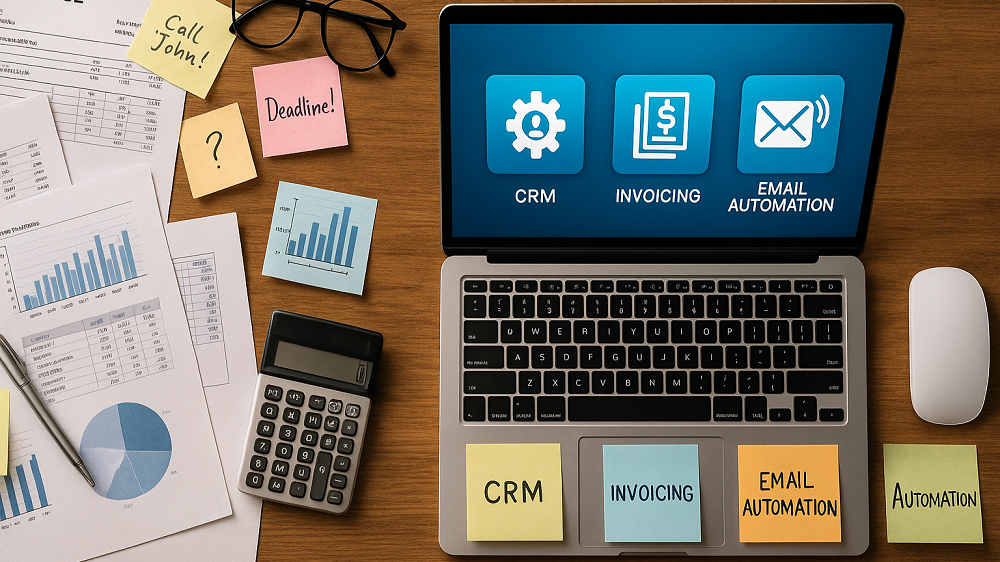For many small business owners, the phrase “digital transformation” sounds like something meant for big corporations with massive budgets and IT departments. You might picture complicated software, endless setup, and the kind of change that disrupts everything you’ve worked hard to build.
But here’s the truth: digital transformation doesn’t have to be scary. It doesn’t have to be expensive. And it’s not about replacing people with technology. It’s about using the right tools to make your business run better, smarter, and more profitably.
What Is Digital Transformation?
Let’s strip away the buzzwords. Digital transformation simply means using technology to improve how your business works.
That could look like:
- Replacing manual paperwork with digital forms
- Using cloud-based accounting instead of spreadsheets
- Setting up online booking so customers don’t have to call
- Automating email follow-ups to stay in touch with leads
- Creating dashboards to see how your business is performing in real time
Digital transformation is not a one-time project. It’s an ongoing shift toward doing things more efficiently using modern tools.
Why Small Businesses Struggle With It
If digital transformation is so helpful, why do many small business owners avoid it?
Here are the most common reasons:
1. Fear of complexity
It’s easy to assume that new tech will take forever to learn or break what’s already working.
2. Lack of time
When you’re busy running the day-to-day, it feels impossible to carve out time to implement something new.
3. Unclear ROI
Without proof that it will pay off, it’s hard to justify investing money or effort.
4. Too many options
With so many tools and platforms available, it’s overwhelming to know where to start.
5. Past tech failures
Bad experiences with clunky tools or overpriced software can make you hesitant to try again.
These concerns are valid. But the right approach can help you avoid those pitfalls and get real results without stress.
The Benefits of Going Digital
Once you start using the right tools, the benefits are immediate and tangible:
- Save time by automating repetitive tasks
- Make smarter decisions with real-time data and reporting
- Improve customer experience through faster service and more convenience
- Increase team productivity by simplifying communication and workflows
- Scale more easily without hiring a larger staff
Instead of doing everything manually or relying on outdated systems, you give your business room to grow and adapt.
Signs It’s Time to Digitally Upgrade
Still not sure if your business needs a tech upgrade? Here are some signs:
- You’re still using pen and paper for important tasks
- It takes hours to pull reports or track key metrics
- Your team wastes time chasing down emails or checking in with each other
- You miss customer follow-ups or lose leads due to poor tracking
- You’re constantly playing catch-up instead of planning ahead
If any of these sound familiar, digital transformation could help you save time, reduce mistakes, and free up your energy for bigger things.
Start Small: Pick One Problem to Solve
You don’t need to overhaul everything at once. The best way to begin is to identify one pain point in your business and fix it with a digital tool.
Here are some common examples:
Problem: Customers have to call or email to schedule appointments
Solution: Use a tool like Calendly or Acuity to allow online booking
Problem: You’re chasing down invoices and payments
Solution: Switch to digital invoicing with QuickBooks, FreshBooks, or Wave
Problem: You can’t see how your business is performing at a glance
Solution: Use a dashboard tool like Google Looker Studio or Databox
Problem: Customer support is inconsistent or slow
Solution: Add a helpdesk tool like Zendesk or even a simple chatbot to your website
The key is to solve one real problem with one simple tool. Then repeat.
Tools That Make Digital Transformation Easy
You don’t need a custom-built system or enterprise software to go digital. Here are categories of tools that work well for small businesses:
1. Accounting and Invoicing
- QuickBooks Online
- Xero
- FreshBooks
- Wave (free)
2. Scheduling and Booking
- Calendly
- Acuity Scheduling
- Square Appointments
3. Team Communication and Project Management
- Slack – Instant messaging for teams
- Asana, Trello, or ClickUp – Visual task and project management
4. CRM and Lead Management
- HubSpot CRM (free tier)
- Zoho CRM
- Pipedrive
5. Marketing Automation
- Mailchimp
- ActiveCampaign
- MailerLite
6. E-commerce and Payments
- Shopify
- Square
- Stripe
- PayPal for Business
Choose tools that are affordable, easy to set up, and integrate with the systems you already use.
What to Watch Out For
Not every tool is a good fit. As you start adding tech, watch out for these common traps:
- Buying too much too fast – Start with what you actually need
- Falling for the “cool” factor – Just because it’s trendy doesn’t mean it’s helpful
- Poor onboarding – Make sure you and your team know how to use the tool
- Overcomplicating – Simpler is usually better
- No plan for implementation – Block out time to set it up properly
A slow, thoughtful rollout is better than rushing into a platform that adds more stress than it saves.
How to Get Your Team On Board
Even the best tools won’t work if your team isn’t using them. Here’s how to encourage adoption:
- Involve them early – Ask for input on what’s slowing them down
- Explain the benefits – Show how it makes their work easier
- Train them well – Use tutorials, walkthroughs, or hire a trainer if needed
- Celebrate wins – When the new system works, share the success
Digital transformation isn’t just a tech shift. It’s a culture shift. The more you involve your team, the smoother the transition.
How to Measure Success
Once you’ve implemented a digital solution, track the results. Ask:
- Is the task faster or easier now?
- Are there fewer errors or delays?
- Are customers getting better service?
- Are we saving money or freeing up time?
- Can we scale this process as we grow?
If the answer is yes, the tool is working. If not, it might be time to adjust or try something else.
Final Thoughts: Make Technology Work FOR You
Digital transformation is not about replacing the heart of your business. It’s about removing the clutter that slows you down and giving you space to focus on what matters: your customers, your team, and your growth.
When done right, technology becomes a trusted partner, not a burden. It helps you do what you already do well, only faster, more consistently, and with less stress.
Start small. Solve real problems. And remember that digital transformation doesn’t have to be scary. It just has to make your life easier.
Sources:
– U.S. Small Business Administration (SBA) https://www.sba.gov
– Score.org https://www.score.org
– HubSpot Blog https://blog.hubspot.com
– Forbes Small Business https://www.forbes.com
– TechSoup https://www.techsoup.org


